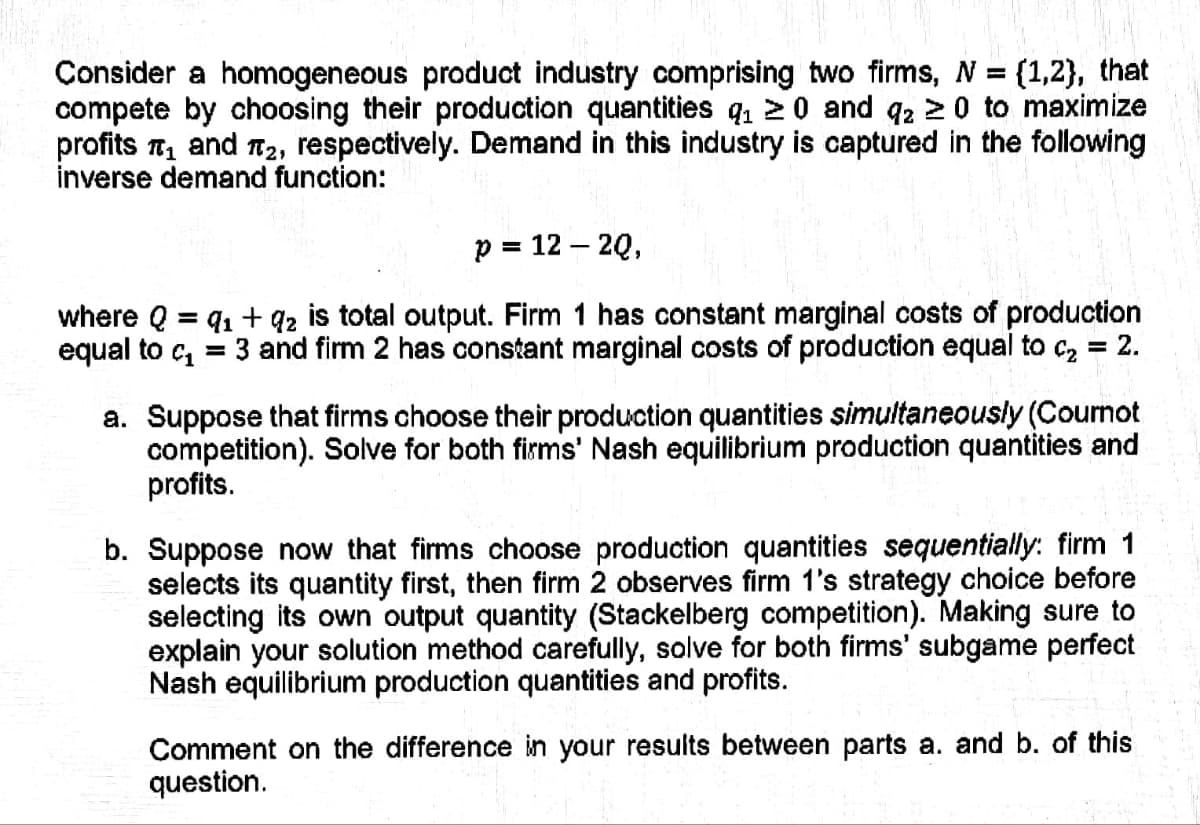Consider a homogeneous product industry comprising two firms, N = {1,2}, that compete by choosing their production quantities q₁ 20 and 92 20 to maximize profits ₁ and 2, respectively. Demand in this industry is captured in the following inverse demand function: p = 12 - 2Q, where Q = 9₁ +92 is total output. Firm 1 has constant marginal costs of production equal to c₁ 3 and firm 2 has constant marginal costs of production equal to c₂ = 2. a. Suppose that firms choose their production quantities simultaneously (Cournot competition). Solve for both firms' Nash equilibrium production quantities and profits. b. Suppose now that firms choose production quantities sequentially: firm 1 selects its quantity first, then firm 2 observes firm 1's strategy choice before selecting its own output quantity (Stackelberg competition). Making sure to explain your solution method carefully, solve for both firms' subgame perfect Nash equilibrium production quantities and profits.
Consider a homogeneous product industry comprising two firms, N = {1,2}, that compete by choosing their production quantities q₁ 20 and 92 20 to maximize profits ₁ and 2, respectively. Demand in this industry is captured in the following inverse demand function: p = 12 - 2Q, where Q = 9₁ +92 is total output. Firm 1 has constant marginal costs of production equal to c₁ 3 and firm 2 has constant marginal costs of production equal to c₂ = 2. a. Suppose that firms choose their production quantities simultaneously (Cournot competition). Solve for both firms' Nash equilibrium production quantities and profits. b. Suppose now that firms choose production quantities sequentially: firm 1 selects its quantity first, then firm 2 observes firm 1's strategy choice before selecting its own output quantity (Stackelberg competition). Making sure to explain your solution method carefully, solve for both firms' subgame perfect Nash equilibrium production quantities and profits.
Managerial Economics: Applications, Strategies and Tactics (MindTap Course List)
14th Edition
ISBN:9781305506381
Author:James R. McGuigan, R. Charles Moyer, Frederick H.deB. Harris
Publisher:James R. McGuigan, R. Charles Moyer, Frederick H.deB. Harris
Chapter16: Government Regulation
Section: Chapter Questions
Problem 6E
Related questions
Question

Transcribed Image Text:Consider a homogeneous product industry comprising two firms, N = {1,2}, that
compete by choosing their production quantities q₁20 and q2 ≥ 0 to maximize
profits ₁ and ₂, respectively. Demand in this industry is captured in the following
inverse demand function:
p = 12 - 2Q,
91 +92 is total output. Firm 1 has constant marginal costs of production
3 and firm 2 has constant marginal costs of production equal to c₂ = 2.
where Q =
equal to ₁ =
a. Suppose that firms choose their production quantities simultaneously (Cournot
competition). Solve for both firms' Nash equilibrium production quantities and
profits.
b. Suppose now that firms choose production quantities sequentially: firm 1
selects its quantity first, then firm 2 observes firm 1's strategy choice before
selecting its own output quantity (Stackelberg competition). Making sure to
explain your solution method carefully, solve for both firms' subgame perfect
Nash equilibrium production quantities and profits.
Comment on the difference in your results between parts a. and b. of this
question.
Expert Solution
This question has been solved!
Explore an expertly crafted, step-by-step solution for a thorough understanding of key concepts.
Step by step
Solved in 3 steps

Knowledge Booster
Learn more about
Need a deep-dive on the concept behind this application? Look no further. Learn more about this topic, economics and related others by exploring similar questions and additional content below.Recommended textbooks for you

Managerial Economics: Applications, Strategies an…
Economics
ISBN:
9781305506381
Author:
James R. McGuigan, R. Charles Moyer, Frederick H.deB. Harris
Publisher:
Cengage Learning

Managerial Economics: Applications, Strategies an…
Economics
ISBN:
9781305506381
Author:
James R. McGuigan, R. Charles Moyer, Frederick H.deB. Harris
Publisher:
Cengage Learning